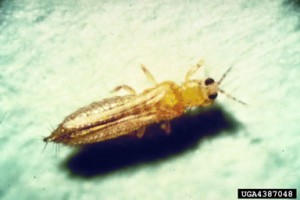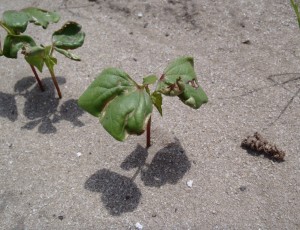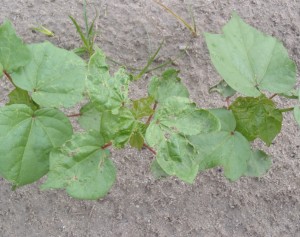Cotton planting time has come and the presence of thrips (Frankliniella sp.) is a reality that growers in the panhandle must deal with every year. With that in mind, it is important that growers have a game plan to manage this harmful insect.
Thrips are tiny insects that feed on seedling cotton plants. Every year, thrips are present in southeastern cotton fields and tend to be found in the highest numbers under conventional tillage.
Once seedlings emerge, they begin feeding on the plant juices of the cotyledon leaves and continue to feed on the young plants until the true four-leaf stage. Thrips feeding injury causes young cotton leaves to pucker and can reduce vigor, stand and ultimately yield. Once the four-leaf stage is reached, however, feeding will not reduce yield.
The goal, then, should be to grow cotton plants to the four-leaf stage as quickly as possible. Factors that can slow plant development into the four-leaf stage are: inadequate soil moisture, inadequate fertility and cool temperatures. All of these factors lead to decrease growth which lengthens the feeding window for thrips.
Many common seed treatments have systemic insecticides which are helpful in deterring thrips damage. Seed treatments that contain imidacloprid (Gaucho, Aeris Seed Applied System, Acceleron-I) or thiamethoxam (Cruiser, Avicta Complete, Acceleron-N) are effective against thrips. If seed treatments do not contain an insecticide, an in-furrow insecticide such as phorate (Thimet) can be used.
In addition to seed treatments it may be necessary to use a foliar application of acephate (Acephate 90, Orthene 90). Be sure to scout cotton as soon as it emerges to determine if thrips are present and feeding. When populations of 2-3 thrips per plant are present, a foliar application is warranted.
Remember that broad-spectrum insecticides such as acephate have activity on predatory insects which help keep other pests, such as spider mites, in check. Therefore, to reduce the risk of future pest issues, only make insecticide applications when absolutely necessary.
For more information on thrips biology and control: MSU Biology and Control of Thirps on Seedling Cotton. If you need assistance identifying thrips, or thirps damage contact your local UF/IFAS County Extension Agent.

Thrips (Frankliniella sp.) is a tiny insect that feeds on many crops, including seedling cotton. Credit: Phil Roberts
- Carinata Starting to Come Up in Jackson County - December 12, 2014
- Wheat Production Considerations for 2014-2015 - November 10, 2014
- Peanut and Cotton Harvest Video 2014 - November 10, 2014


